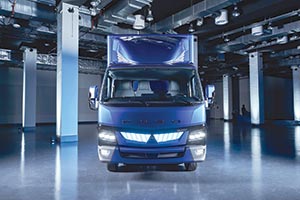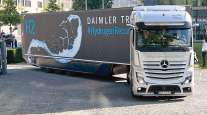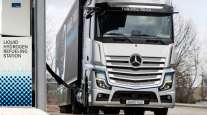Electric Is the Buzz at IAA

This story appears in the Oct. 3 print edition of Transport Topics.
HANOVER, Germany — The loudest buzz at the IAA Commercial Vehicles Show came from a technology not meant to be heard.
Electric vehicles, powered by advancements in battery technology developed after several European cities said they plan to ban diesel vehicles to cut pollution and noise, were easy to spot throughout the fairgrounds here.
“We are reaching a tipping point, and that tipping point will be the end of this decade, where, suddenly, the application of electric-driven vehicles will start to kick in,” Wolfgang Bernhard, head of Daimler AG’s global commercial vehicles unit, said during a Sept. 21 roundtable.
While many of the electric trucks, vans and buses were concept vehicles presented for non-U.S. markets, Daimler announced it would begin selling the Fuso eCanter delivery truck in Europe, the United States and Japan in 2017, and a Mercedes-Benz electric van in 2018. The eCanter was first shown in the United States at the Work Truck Show earlier this year.
“While heavy electric trucks may be some way from production reality,” the Fuso eCanter and Volkswagen’s debut of its e-Crafter concept van could “help bring a step change towards electrically-powered delivery vehicles in urban environments,” IHS Markit said in a blog post after IAA media day.
Bernhard noted that while he had been skeptical of electric vehicles, a 2.5-fold increase in battery performance and equal decrease in cost in recent years forced him to change his mind.
Marc Llistosella, president of Daimler Trucks Asia, said Fuso was working with large U.S. fleets and other potential customers in areas where electric vehicles make the most sense, such as California. Currently, the eCantor’s range is about 62 miles (100 kilometers), which is sufficient for operations in Europe and Japan. However, success in the U.S. market will require them to offer a range of about 93 miles (150 km), he said.
Daimler said the eCanter uses a 185-kilowatt electric motor with about 280 pound-feet of torque.
Batteries are spread over five units, one in the frame behind the cab and two on each side of the frame, and can be configured to accommodate higher payloads or greater range.
Detailed plans on the eCanter came after Daimler showed its electric heavy-duty concept Urban eTruck and Vision Van during a Sept. 20 event.
Llistosella said that part of the development strategy could include providing financial assistance for larger companies seeking a “super charging” station at their facilities and creating a program to allow upgrades of the battery packs as the technology further develops. Standard AC charging systems will allowthe trucks to be fully charged if plugged in overnight.
For charging on the road, Llistosella suggested the “connected” truck could alert a driver to what charging systems are available and secure a reservation. Llistosella added that he believes there needs to be a single standard for charging, as opposed to individual proprietary systems.
Bernhard said that, in time, electric vehicles would be produced within local markets, because shipping batteries is difficult as they are hazardous materials. Initially, though, the eCanter will be imported into the United States as Daimler wrestles with improvements in areas such as battery cooling and maintaining mileage range when power is needed to heat the cab in cold weather.
Meanwhile, Volkswagen said its e-Crafter concept van has a range of about 124 miles and can handle loads up to 3,750 pounds. It can be charged in about 45 minutes, has a top speed of 50 mph and is “near production-ready.”
“The e-Crafter’s design already takes into account future battery developments, with which — depending on customer requirements and specifications — freely configurable ranges of up to [250 miles] become possible,” the company said. In a speech prior to the opening of IAA, Andreas Renschler, head of the Volkswagen Truck & Bus division, said electriconly buses would come first in cities.
“There is no dispute that vans and even heavy-duty distribution trucks will follow,” he said. Also at IAA, VW’s MAN SE unit presented its concept City Truck, an electrically powered tractortrailer for use in city deliveries.
It has a permissible gross weight of 36,000 pounds, the low end of Class 8, and is powered by a 250 kW electric motor. It also showed a fully electric bus. While engine maker Cummins Inc.’s press conference focused predominantly on advancements of its diesel engines, CEO Tom Linebarger discussed the electrification trend during his opening remarks.
“The last couple of years there has been rapid growth in electrified vehicles. We’ve seen them for years, but they are now starting look like they are going to show up for real in commercial applications, especially in urban centers,” he said.
Linebarger noted that Cummins is involved in a number of projects, including an extended-range electrical bus in Quebec. Additionally, Eaton Corp. showed several transmissions for heavy- and medium-duty electric commercial vehicle applications for Europe and other markets.
Larry Bennett, Eaton’s director of engineering, said transmission advancements could help take some of the stress from the battery and reduce the size of electric motors, providing better range and overall performance.




